News
from Cape Canaveral
Archives December 2017
December
28, 2017
Falcon
Heavy Raised Vertically On Launch Pad 39A
Reported
by Cliff Lethbridge
A SpaceX Falcon Heavy rocket was raised vertically on
Launch Pad 39A today. This marks the first time a Falcon Heavy has been erected
at the launch pad. The rocket is expected to be lowered to a horizontal
position and returned to its assembly hangar tomorrow. Still no word on when
the rocket will again be raised vertically at the launch pad for a planned test
firing of its 27 first stage booster engines, capable of producing over 5
million pounds of thrust at liftoff. The Falcon Heavy will be making its maiden
launch, still scheduled for some time in January,
2018. Set to perform a demonstration flight, the rocket will carry a Tesla
Roadster automobile on a deep space trajectory.

Falcon Heavy Rocket On Launch Pad 39A, Photo Courtesy SpaceX
________________________________________________________________________________
December
26, 2017
SpaceX
Releases Photos Of Falcon Heavy Payload
Reported
by Cliff Lethbridge

Tesla Roadster Falcon
Heavy Payload, Photo Courtesy SpaceX
SpaceX has released photos of the payload set to fly
aboard a Falcon Heavy rocket on its maiden flight scheduled for January, 2018. The payload is indeed a red Tesla Roadster
automobile that will be sent on a solar orbit at approximate Mars distance.
SpaceX and Tesla head Elon Musk has said that he hopes the automobile will
remain in orbit for “billions” of years. The photos depict the automobile
perched inside the cavernous Falcon Heavy composite payload fairing.
Officially, the Falcon Heavy rocket will be performing a demonstration flight.
Musk has maintained that there is a high probability that the mission will not
be successful.

Tesla Roadster Falcon
Heavy Payload, Photo Courtesy SpaceX
__________________________________________________________________________________
December 20, 2017
SpaceX Unveils
Falcon Heavy Rocket
Reported by Cliff
Lethbridge
SpaceX today released photos of a Falcon Heavy rocket
targeted for its maiden launch in January, 2018. The
photos were taken inside a horizontal assembly hangar adjacent to Launch Pad
39A, from which the launch is scheduled to occur. The Falcon Heavy is comprised
of three Falcon 9 first stage booster cores strapped together, with a total of
27 engines fired at liftoff. The rocket can produce 5.13 million pounds of
thrust at launch, making it the world’s most powerful launch vehicle. Historically,
the Falcon Heavy is second only to the mighty Saturn V in liftoff thrust. The
Saturn V produced 7.5 million pounds of thrust at launch.
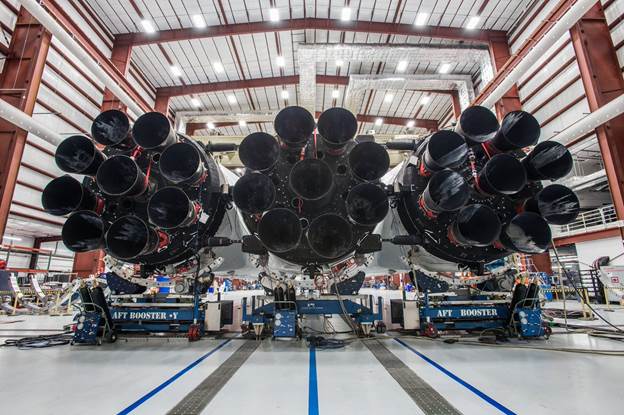
Falcon Heavy Triple Core
Booster Engines, Photo Courtesy SpaceX
The Falcon Heavy rocket stands 229.6 feet tall with a
total width of 39.9 feet. Fully fueled, the rocket has a total mass of 3.125
million pounds at launch. The rocket can carry a composite fairing or a Dragon
capsule, depending on mission requirements. Like the Falcon 9 rocket, the
Falcon Heavy first stage and second stage burn a combination of liquid oxygen
and RP-1 (kerosene) fuel. All three first stage core booster segments are
recoverable. The outside two core boosters will both land at Cape Canaveral Air
Force Station Landing Zone 1, while the central core booster will be recovered
on a barge at sea.
With the capability of carrying a maximum 140,600
pounds of payload to Low Earth Orbit, the Falcon Heavy performance is far and
above that of comparable launch vehicles. Payload capability to Low Earth Orbit
of the Falcon Heavy is roughly three times greater than the Space Shuttle and
Delta IV Heavy, and roughly four times greater than the Atlas V. The Falcon Heavy
can also carry a maximum 58,860-pound payload to Geostationary Transfer Orbit,
a maximum 37,040-pound payload to Mars or a maximum 7,720-pound payload to
Pluto. The first Falcon Heavy launch will be a demonstration flight, but SpaceX
has said that the rocket will carry a Tesla automobile which will be sent on a
deep space trajectory.
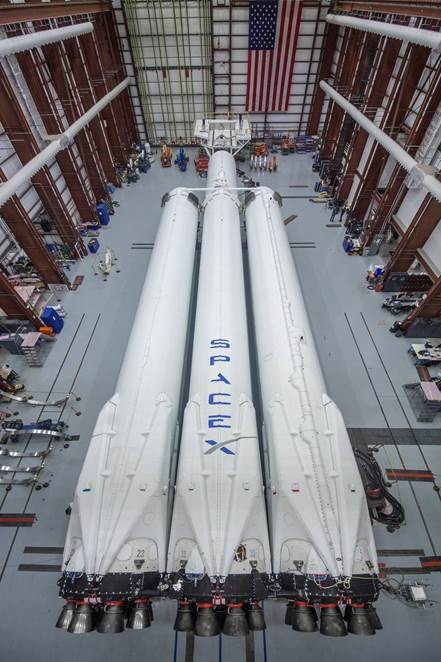
Falcon Heavy Rocket,
Photo Courtesy SpaceX
______________________________________________________________________________
December 19, 2017
Merry Christmas As
Spaceline Remembers Apollo 8
Reported by Cliff
Lethbridge
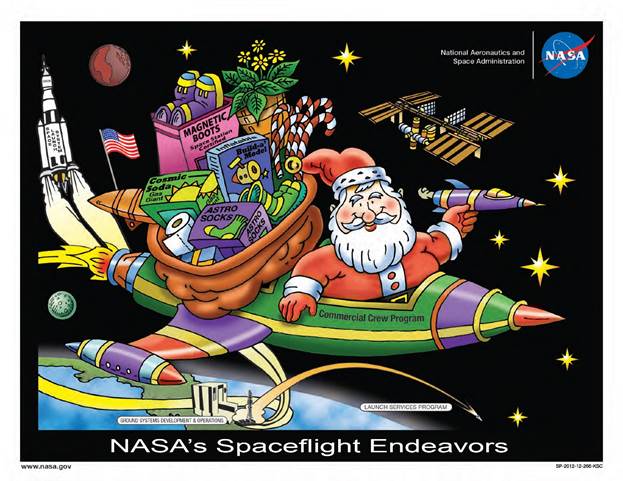
Santa Claus In Space,
File Photo Courtesy NASA
Christmas had been celebrated in space for many years
now. Apollo 8, Skylab 4, STS-103 and crews aboard the International Space
Station have all celebrated Christmas in space. Santa Claus actually
visited Space Shuttle Discovery during STS-103, a Hubble Space Telescope
servicing mission, on Christmas Eve, 1999. Mission controllers in Houston were
stunned as Santa visited Discovery in the dead of night, delivering presents
for the seven-member crew.

Expedition 42
Astronaut Samantha Cristoforetti Aboard ISS, File Photo Courtesy NASA
But for those of us who have been around for a while,
the most memorable Christmas mission remains Apollo 8, mankind’s first journey
to the Moon and back. While Apollo 8 astronauts Frank Borman, James Lovell and
William Anders orbited the Moon on Christmas Eve, 1968, they took time to read
from the Bible’s Book of Genesis Chapter 1, verses 1 through 10, King James
version. The reading was included as part of a televised broadcast, which at
the time was the most watched broadcast in television history.

Astronaut William
Anders Aboard Apollo 8, File Photo Courtesy NASA
Astronaut William Anders began:
We
are now approaching lunar sunrise, and for all the people back on Earth, the
crew of Apollo 8 has a message that we would like to send to you. In the
beginning, God created the heaven and the earth, and the earth was without
form, and void; and darkness was upon the face of the deep. And the Spirit of
God moved upon the face of the waters. And God said, Let
there be light; and there was light. And God saw the light, that it was good;
and God divided the light from the darkness.
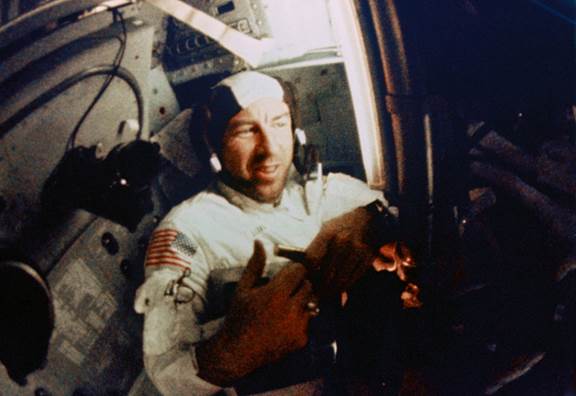
Astronaut James
Lovell Aboard Apollo 8, File Photo Courtesy NASA
Astronaut James Lovell continued:
And
God called the light Day, and the darkness He called Night. And the evening and
the morning were the first day. And God said, Let
there be a firmament in the midst of the waters, and let it divide the waters
from the waters. And God made the firmament, and
divided the waters which were under the firmament from the waters which were
above the firmament, and it was so. And God called the firmament Heaven. And
the evening and the morning were the second day.
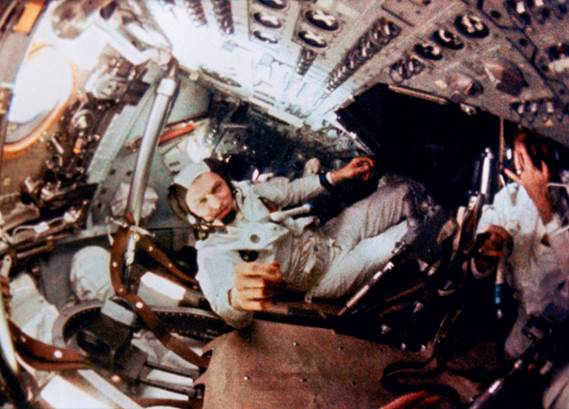
Astronaut Frank
Borman Aboard Apollo 8, File Photo Courtesy NASA
Astronaut Frank Borman concluded:
And
God said, Let the waters under the heaven be gathered together unto one place,
and let the dry land appear; and it was so. And God called the dry land Earth;
and the gathering together of the waters called He seas; And God saw that it was good. And from the crew of
Apollo 8, we close with good night, good luck, a Merry Christmas, and God bless
all of you, all of you on the good Earth.
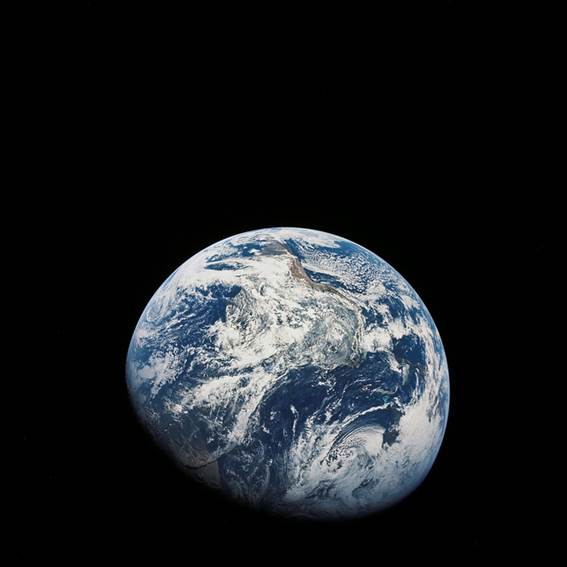
The “Good Earth”
Photographed During Apollo 8, File Photo Courtesy NASA
It was one of those really
significant and memorable broadcasts in the history of the U.S. space
program, not that secular concerns were ignored. On Christmas Day, 1968, the
Apollo 8 crew performed a Trans-Earth Injection burn, which was conducted from
the dark side of the Moon, out of reach of communication with Earth. Once voice
contact was restored, astronaut James Lovell exclaimed, Please be informed, there IS a Santa Claus! Ken Mattingly, the Mission
Control Capsule Communicator at the time, replied, That’s affirmative, you are the best ones to know!
We hope this humble article brings back Christmas
memories, or creates new ones. Merry Christmas from all of us here at
Spaceline!
______________________________________________________________________________
December 15, 2017
Falcon 9
Successfully Launches CRS-13 For NASA
Reported by Cliff
Lethbridge

SpaceX Falcon 9 Launches With
CRS-13 Payload, Photo Courtesy NASA
A
SpaceX Falcon 9 rocket carrying the CRS-13 payload was successfully launched
from Cape Canaveral Air Force Station Launch Pad 40 at 10:36 a.m. EST today.
Launch Pad 40 is now officially back in service following a Falcon 9 explosion
on the pad in September 2016. This gives SpaceX added flexibility with two
active Cape launch pads, Launch Pad 40 and Launch Pad 39A, which is currently
undergoing renovation for the mammoth Falcon Heavy rocket, targeted for its
maiden launch in early 2018.
The
CRS-13 payload consists of a Dragon capsule bound for the International Space
Station (ISS). The Dragon capsule will be docked to ISS on Sunday, December 17.
Today’s Falcon 9 launch featured two pieces of flight proven hardware. The
Falcon 9 first stage booster was previously flown on CRS-11 launched in June
2017 while the Dragon capsule was previously flown on CRS-6 in April, 2015. The Falcon 9 first stage booster launched today
completed a successful landing at Cape Canaveral Air Force Station Landing Zone
1, formerly Launch Complex 13. Launch was conducted under the NASA Commercial
Resupply Services contract.
The
SpaceX Dragon capsule carries about 4,800 pounds of International Space Station
supplies and equipment, divided into pressurized and unpressurized payloads.
Pressurized payloads include about 1,000 pounds of crew supplies, 1,500 pounds
of science investigations, 350 pounds of spacewalk equipment, 400 pounds of
vehicle hardware and 10 pounds of computer resources. A total of about 1,400
pounds of equipment and supplies are unpressurized. Scientific investigations
carried include:
Plant
Gravity Perception (PGP), which is designed to study how plants sense and
respond to gravity; Biorasis Glucose Biosensor (BGB),
which seeks to improve the accuracy of a wireless medically implantable
continuous glucose biosensor for day-to-day diabetes management; Total and
Spectral Solar Irradiance Sensor (TSIS), which measures total solar irradiance
and solar spectral irradiance to help determine Earth’s total energy input from
the Sun; Space Debris Sensor (SDS) which is a calibrated impact sensor designed
to directly measure the International Space Station orbital debris environment
for a period of two to three years.

Falcon 9 First Stage Booster
Approaches Landing Zone 1, Photo Courtesy NASA
December 12, 2017
CRS-13 Launch
Delayed Again
Reported by Cliff
Lethbridge
Launch
of the CRS-13 payload aboard a SpaceX Falcon 9 rocket has been postponed again.
Launch is now targeted for Friday, December 15, 2017 at 10:35 a.m. EST. SpaceX reported
that the delay will allow additional time for the launch team to conduct full
inspections and cleanings due to detection of particles in the Falcon 9 second
stage fuel system. The company said that if the launch does not occur on
Friday, it will be postponed to no earlier than late December. The CRS-13
payload consists of a SpaceX Dragon capsule filled with about 4,800 pounds of
supplies and equipment for the International Space Station. Launch will occur
from Cape Canaveral Air Force Station Launch Pad 40, which will host its first
launch since a Falcon 9 rocket exploded on the pad in September 2016. The
launch is being conducted under the NASA Commercial Resupply Services contract.

Falcon 9 Rocket In
Flight, File Photo Courtesy SpaceX
December 11, 2017
CRS-13 Launch
Delayed
Reported by Cliff
Lethbridge
Launch
of the CRS-13 payload aboard a Falcon 9 rocket scheduled for December 12, 2017
has been postponed. The launch is now scheduled for Wednesday, December 13 at
11:24 a.m. EST. SpaceX reported that the delay will allow additional time for
pre-launch ground system checks. The CRS-13 payload consists of a SpaceX Dragon
capsule filled with about 4,800 pounds of supplies and equipment bound for the
International Space Station. Launch will occur from Launch Pad 40 on Cape
Canaveral Air Force Station, which is hosting its first launch since a Falcon 9
rocket exploded on the pad in September 2016. The launch is being conducted under
the NASA Commercial Resupply Services contract. For the latest updates, click
“Launch Schedule” above. It is typically updated before stories are posted
here.
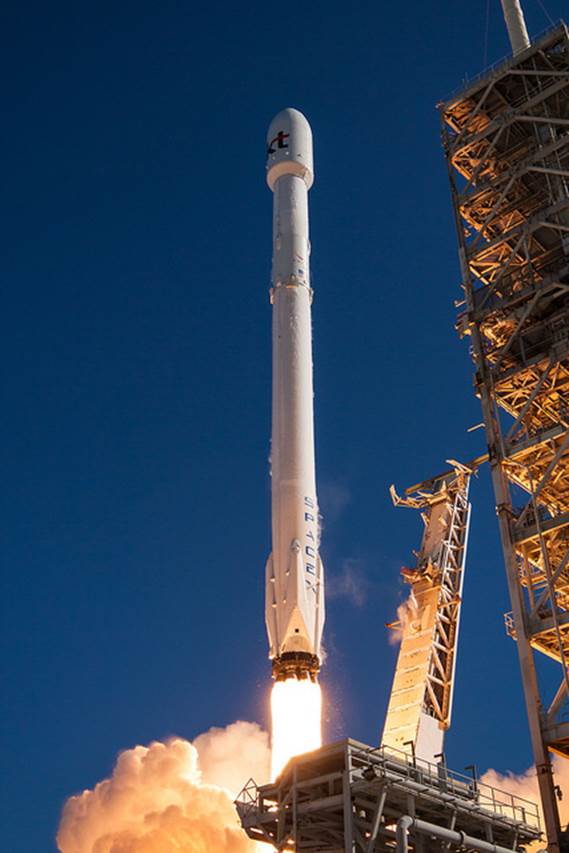
Falcon 9 Launch, File Photo
Courtesy SpaceX
December 6, 2017
CRS-13 And Other
Launch Updates
Reported by Cliff
Lethbridge
The
CRS-13 launch aboard a SpaceX Falcon 9 rocket has been postponed again, this
time to Tuesday, December 12 at 11:46 a.m. EST. CRS-13 consists of a SpaceX
Dragon capsule which carries supplies and equipment for the International Space
Station (ISS). CRS-13 will dock with ISS two days after launch and the mission
is being conducted as part of the NASA Commercial Resupply Services contract.
Launch will be from Cape Canaveral Air Force Station Launch Pad 40, which will
return to service after refurbishment resulting from a Falcon 9 launch pad
explosion at the site in September 2016.
In
other launch news, the mysterious ZUMA payload previously scheduled for launch
from Launch Pad 39A atop a Falcon 9 rocket on November 15, 2017 has been
rescheduled for a target date of January 4, 2018. The launch was postponed
while SpaceX investigated potential payload fairing problems discovered during
preparation for another mission. As surmised in a previous Spaceline News
article, the launch of ZUMA, an undisclosed government payload, has been
relocated to Launch Pad 40 but will likely occur before the launch of a Falcon
Heavy rocket which is targeted for January, 2018 from a renovated Launch Pad
39A. Launch of an Atlas V rocket carrying the Air Force SBIRS GEO-4 payload
from Launch Pad 41 remains scheduled for January 18, 2018 while the launch of a
Falcon 9 rocket from Launch Pad 40 carrying the commercial SES-16/GOVSAT-1
payload is targeted for January 30, 2018.
For the latest updates on launch activity at Cape
Canaveral, click “Launch Schedule” above.

Falcon 9 Booster
Landing, File Photo Courtesy SpaceX
December 6, 2017
CRS-13 Falcon 9
Static Test Firing
Reported by Cliff
Lethbridge
SpaceX
today conducted a static test fire of a Falcon 9 first stage booster on Cape
Canaveral Air Force Station Launch Pad 40, the first time a rocket has been
fired there since a Falcon 9 rocket exploded on the pad in September 2016. The
test firing of the Falcon 9’s nine first stage engines for several seconds
occurred at 3:00 p.m. EST in advance of the upcoming CRS-13 launch now targeted
for Tuesday, December 12 at 11:46 a.m. These static test fires are conducted to
validate fueling operations, ground equipment and engine performance. SpaceX
reported that the test firing was successful. CRS-13 consists of a Dragon space
capsule that will carry supplies and equipment to the International Space
Station under the NASA Commercial Resupply Services contract.

Falcon 9 On Launch
Pad 40, File Photo Courtesy SpaceX
December 4, 2017
CRS-13 Launch
Update
Reported by Cliff
Lethbridge
Launch
of the CRS-13 payload aboard a SpaceX Falcon 9 rocket previously scheduled for December
4, 2017 has been postponed to Saturday, December 9, 2017. No reason for the
delay has been announced. CRS-13 will dock with the International Space Station
with supplies and equipment under the Commercial Resupply Services contract
with NASA. Launch time on December 9 is 12:57 p.m. EST. This will be the first
launch from Cape Canaveral Air Force Station Launch Pad 40 since it was
destroyed by a Falcon 9 explosion in September 2016.
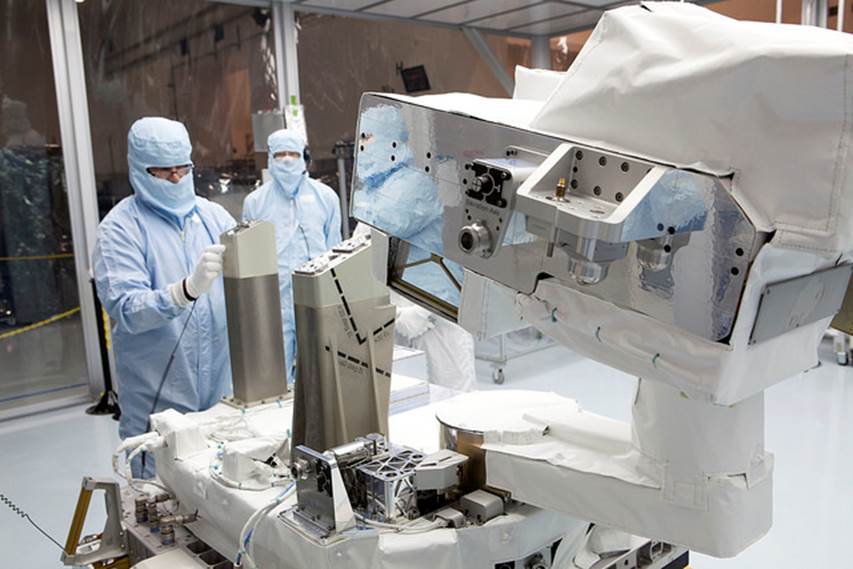
CRS-13 Payload Processing, Photo
Courtesy NASA
December 4, 2017
Falcon Heavy
Launch Update
Reported by Cliff
Lethbridge
The
maiden launch of a SpaceX Falcon Heavy rocket has been postponed to no earlier
than January 2018. SpaceX head Elon Musk has said that the rocket will carry
his Tesla Roadster automobile on a Mars or deep space trajectory, but that has
not been confirmed. Launch of the Falcon Heavy has been delayed from 2015. It
will be the most powerful modern unmanned rocket. Launch will be from Launch
Pad 39A, which is currently being renovated for the Falcon Heavy. Launch of the
mysterious ZUMA payload aboard a Falcon 9 rocket from Launch Pad 39A previously
scheduled for November 15, 2017 has been postponed indefinitely as SpaceX
investigates potential payload fairing problems. Launch of ZUMA, an undisclosed
government payload, will likely not occur until after the Falcon Heavy and may
be moved to Launch Pad 40, which is now back in service following a Falcon 9
explosion in September 2016.
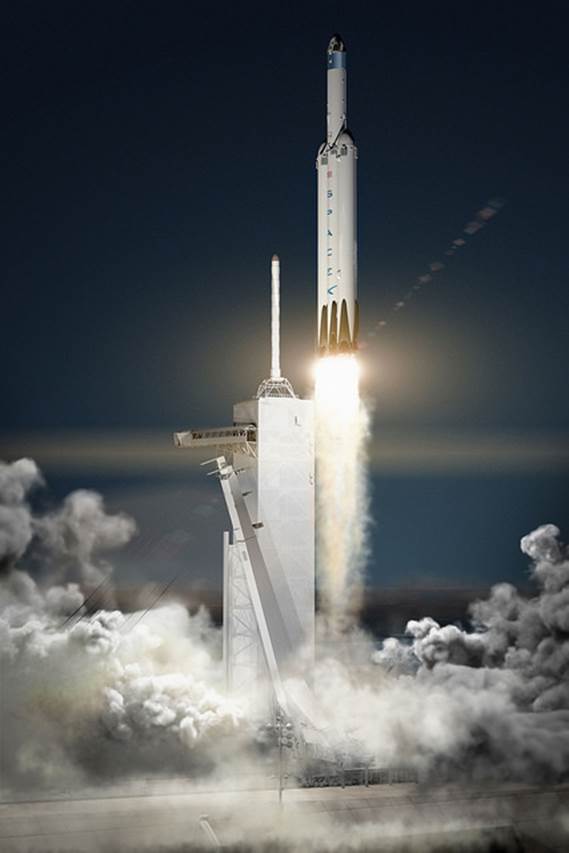
Falcon Heavy Artist Conception,
Photo Courtesy SpaceX